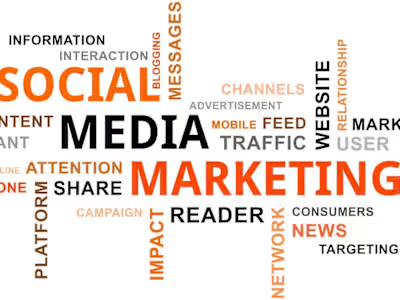Embracing the Future: Emerging Technologies in Social Med
Like this project
Posted Dec 15, 2023
AI written content and fully formatted.
In the ever-evolving realm of digital marketing, the integration of cutting-edge technologies has become a pivotal factor for success. Social media, once a simple platform for connecting people, has now transformed into a dynamic landscape where businesses leverage emerging technologies to engage, captivate, and convert their audience. In this exploration, we delve into the world of emerging technologies in social media marketing, unveiling how AI, AR, and VR are reshaping the way brands connect with their audience.
The Rise of Artificial Intelligence (AI) in Social Media Marketing
Artificial Intelligence has emerged as a game-changer in social media marketing, revolutionizing the way brands interact with users. AI's ability to analyze vast amounts of data at incredible speeds allows marketers to gain profound insights into user behavior, preferences, and trends. This data-driven approach enables businesses to create highly targeted and personalized content, resonating with their audience on a deeper level.
1. Personalization at Scale:
AI algorithms can analyze user interactions and preferences, allowing businesses to deliver personalized content to individuals on a mass scale. From tailored product recommendations to customized messages, AI ensures that every interaction feels uniquely relevant to the user.
2. Chatbots Enhancing Customer Interaction:
Chatbots, powered by AI, have become invaluable tools for improving customer service on social media. These intelligent bots can handle routine queries, provide instant responses, and guide users through various processes. This not only enhances the user experience but also frees up human resources for more complex tasks.
3. Predictive Analytics for Strategic Decision-Making:
AI-driven predictive analytics empowers marketers to forecast trends and anticipate consumer behavior. By analyzing historical data and identifying patterns, businesses can make informed decisions, refine their strategies, and stay ahead of the competition.
Augmented Reality (AR): Transforming User Engagement
Augmented Reality is breaking down barriers between the digital and physical worlds, providing a new dimension to social media marketing. By overlaying digital elements onto the real world, AR creates immersive and interactive experiences for users.
1. AR Filters and Lenses for Brand Interaction:
Snapchat and Instagram have paved the way for AR filters and lenses, allowing users to engage with brands in playful and creative ways. From trying on virtual products to participating in branded challenges, AR filters offer a unique avenue for brand interaction.
2. Virtual Try-On Experiences:
In the realm of e-commerce, AR is transforming the way users shop online. Virtual try-on experiences enable customers to visualize products in their real-world environment before making a purchase decision. This not only reduces returns but also enhances the overall shopping experience.
3. Interactive Advertising Campaigns:
AR opens up new possibilities for interactive advertising campaigns. Brands can create AR-powered advertisements that users can engage with by scanning images or objects. This interactivity not only captures attention but also leaves a lasting impression on the audience.
Virtual Reality (VR): Immersing Audiences in Brand Narratives
Virtual Reality takes the concept of immersion to a whole new level, offering users a fully immersive experience within a digital environment. While VR is still in its early stages for social media marketing, its potential is undeniable.
1. Virtual Brand Experiences:
Brands can use VR to transport users to virtual spaces that reflect their identity and values. Virtual brand experiences, such as 360-degree tours or VR events, enable users to engage with the brand in a more profound and memorable way.
2. Storytelling in 360 Degrees:
VR allows brands to tell stories in 360 degrees, providing a panoramic view that captivates users. Whether showcasing behind-the-scenes footage or taking users on a virtual journey, this technology creates a more immersive and emotionally resonant narrative.
3. Virtual Events and Product Launches:
With the rise of remote work and online experiences, VR can play a significant role in hosting virtual events and product launches. Brands can create virtual spaces for users to explore, interact, and participate in events as if they were physically present.
The Symbiosis of AI, AR, and VR: A Holistic Approach
While each technology—AI, AR, and VR—brings unique capabilities to the table, their true potential is unlocked when integrated seamlessly. The symbiosis of these technologies allows brands to create comprehensive and personalized experiences for users.
1. AI-Enhanced AR and VR Experiences:
Combining AI with AR and VR amplifies the level of personalization in user experiences. AI algorithms can analyze user preferences in real-time, dynamically adjusting AR filters or VR content to cater to individual tastes.
2. Data-Driven Insights for Continuous Improvement:
The integration of AI provides continuous data-driven insights into the performance of AR and VR campaigns. Marketers can refine their strategies based on real-time analytics, ensuring that their immersive experiences resonate effectively with the target audience.
3. Adaptive Content Delivery:
AI-driven algorithms can adapt content delivery based on user interactions in AR and VR environments. This adaptability ensures that users receive content that aligns with their preferences, creating a more fluid and engaging experience.
Overcoming Challenges and Embracing the Future
While the integration of emerging technologies in social media marketing presents exciting opportunities, it also comes with challenges. Privacy concerns, technological barriers, and the need for skilled professionals are among the obstacles businesses may face. However, by staying informed, investing in technological infrastructure, and fostering a culture of innovation, businesses can overcome these challenges and position themselves at the forefront of the evolving social media landscape.
In conclusion, the integration of AI, AR, and VR in social media marketing is not a distant future; it is happening now. Businesses that embrace these technologies gain a competitive edge by delivering personalized, immersive, and engaging experiences to their audience. As we navigate this ever-changing landscape, the key lies in understanding the unique strengths of each technology and leveraging their synergies to create holistic and impactful social media campaigns. The future of social media marketing is not just about reaching audiences; it's about creating meaningful connections that leave a lasting impression in the hearts and minds of users.





